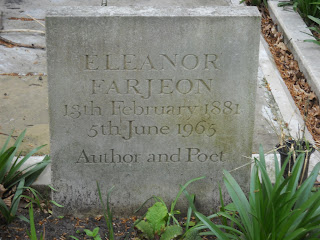The
Little Bookroom
Eleanor Farjeon
Out of all everything that I’ve ever wanted in life, near the
top of the list would be my own private library. I imagine a room with floor to ceiling
bookcases and a moving ladder so I can reach the top shelves. There’s a desk in
my library and of course, an old brown chesterfield so that I can laze the day
away with a good book and a curled up cat. My library consists of classics and
travel books so that I can continue to pursue the classic writers I’ve fallen
in love with over the past 49 years. There’s a special place for my sacred blog
books and the sun streams through the window in the afternoons. It might sound cliché to you, but to me, this
is paradise.
If we leave my private library and go into an attic with
piles of dusty books that have not been arranged in any logical order, we enter the childhood of Eleanor Farjeon. I can only
imagine how wonderful it must have been to spend time rummaging for something
that introduces you to new characters and places you’ve never been, in a
private world of your own.
At the age of five, Eleanor Farjeon’s father encouraged her
to start writing. She has been described as a timid child and was known to her
family as ‘Nellie’. Farjeon suffered poor eyesight and ill-health and spent a
lot of her time in the attic reading. Her inspiration for her most famous book,
Martin Pippin in the Apple Orchard, came not from that quiet attic, but from
family holidays.
 |
| A compilation of Eleanor Farjeon's favourites |
After World War I, Farjeon earned a living as a poet and if
you don’t think you know any of her work then think again. Eleanor Farjeon is responsible for the lyrics
to the Hymn Morning has Broken. The correct title of the poem is ‘A Morning Song
(for the first day of spring)’. This was also made popular in the 70’s by Cat
Stevens and was number one on the US charts. There is a link at the end of the blog for your entertainment
Eleanor Farjeon was born in 1881 and passed away in
1965. I’ve seen some changes throughout
my life, but coming from the Victorian age to the Swinging Sixties must have
been a whirlwind of an adventure. Throughout those years, she became friends
with writers such as D H Lawrence and Walter de la Mare. Although she loved
children, she never had any of her own, which is kind of a shame because it’s
always nice to read the stories that you’ve written to your own children.
 |
| Farjeon's grave in the Churchyard of St John-at-Hampstead |
In the little attic book room, Eleanor Farjeon developed a
ferocious appetite for words and literature.
She knew how to reach children with her writing and created incredible
adventures that make you want to dance in a barn.
Like Eleanor Farjeon,
I love to read and I love to write. One day I’ll have that library that I’ve
dreamt of for so long now, but at the moment I’m happy to be inspired by a girl from Victorian England whose imagination developed
Once upon a time in a dust filled attic
full of stories and adventures.
http://www.youtube.com/watch?v=e0TInLOJuUM






